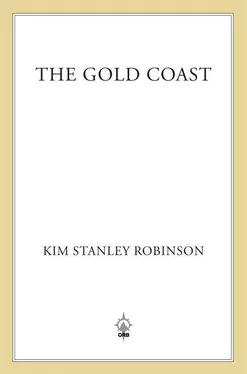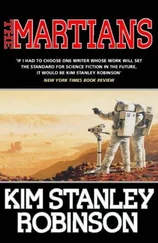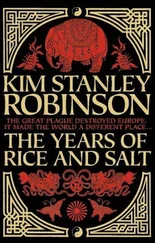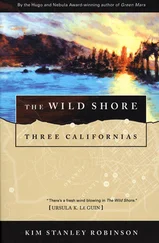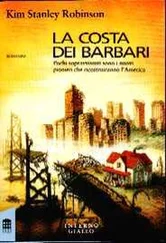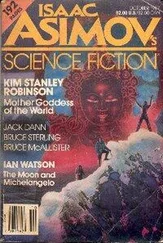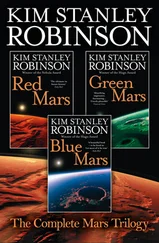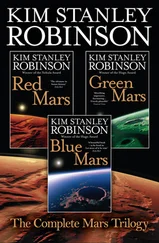Kim Stanley Robinson
Gold Coast
(Orange County 2)


Beep beep!
Honk honk.
Jim McPherson sticks his head out the window of his car, shouts at a Minihonda whose program has just automatically slotted it onto the onramp ahead of him. “You cut me off!” The man in the Minihonda stares back at him, looking puzzled. Jim’s ancient Volvo swerves sharply up the curving track and suddenly Jim’s hanging halfway out the window and teetering, face inches from the concrete of the freeway. Abe Bernard grabs his belt and pulls him back in, whew!
Night in Orange County, here, and the four friends are cruising in autopia. Stars of their high school state championship wrestling team, ten years past that glory, they roll over the seats of the Volvo and try to pin Tashi Nakamura, to keep him away from the eye-dropper of Sandy Chapman’s latest concoction. Tash was their heavyweight and the only one still in good shape, and they can’t do it; Tash surges up through their arms and seizes the eyedropper, all the while singing along with one of Jim’s old CDs: “ Some body give me a cheese burger!” The onramp bends up, curves more sharply, the contacts squeak over the power-and-guidance electromagnetic track in the center of the lane, they’re all thrown into a heap on the backseat. “Uh-oh, I think I dropped the dropper.” “Say, we’re on the freeway now, aren’t we? Shouldn’t someone be watching?”
Instantly Abe squirms into the driver’s seat. He has a look around. Everything’s on track. Cars, following their programs north, hum over the eight brassy bands marking the center of each lane. River of red taillights ahead, white headlights behind, some cars rolling over the S-curved lane-change tracks, left to right, right to left, their yellow turnsignal indicators blinking the rhythm of the great plunge forward, click click click, click click click. All’s well on the Newport Freeway tonight. “Find that eyedropper?” says Abe, a certain edge in his voice.
“Yeah, here.”
The northbound lanes swoop up as they cross the great sprawl of the intersection with the San Diego, Del Mar, Costa Mesa, and San Joaquin freeways. Twenty-four monster concrete ribbons pretzel together in a Gordian knot three hundred feet high and a mile in diameter—a monument to autopia—and they go right through the middle of it, like bugs through the heart of a giant. Then Jim’s old buzzbox hums up a grade and suddenly it’s like they’re in a landing pattern for John Wayne International Airport over to their right, because the northbound Newport is on the highest of the stacked freeway levels, and they are a hundred feet above mother Earth. Nighttime OC, for miles in every direction. Imagine.
The great gridwork of light.
Tungsten, neon, sodium, mercury, halogen, xenon.
At groundlevel, square grids of orange sodium streetlights.
All kinds of things burn.
Mercury vapor lamps: blue crystals over the freeways, the condos, the parking lots.
Eyezapping xenon, glaring on the malls, the stadium, Disneyland.
Great halogen lighthouse beams from the airport, snapping around the night sky.
An ambulance light, pulsing red below.
Ceaseless succession, redgreenyellow, redgreenyellow.
Headlights and taillights, red and white blood cells, pushed through a leukemic body of light.
There’s a brake light in your brain.
A billion lights. (Ten million people.) How many kilowatts per hour?
Grid laid over grid, from the mountains to the sea. A billion lights.
Ah yes: Orange County.
Jim blinks a big wash of Sandy’s latest out of his eye, watches patterns pulse. All at once, in a satori illumination, he can see the pattern all the other patterns make: the layers of OC’s lighting, decade on decade, generation on generation. In fact certain grids are lifting off and pivoting ninety degrees, to match the metapattern of the perceived whole. “I’d call this one Pattern Perception.”
“Okay,” Sandy says. “I can see that.”
“You could take aspirin and see that from up here,” Abe objects.
“That’s true. I can see that too.”
“Ought to call it Agreeability,” says Tashi.
“That’s true. I can see that.”
“We’re at the center of the world,” Jim announces. Abe and Tashi start looking around like they missed the marker—should be a plaque or something, right? “Orange County is the end of history, its purest product. Civilization kept moving west for thousands of years, in a sunset tropism, until they came to the edge here on the Pacific and they couldn’t go any farther. And so they stopped here and did it. And by that time they were in the great late surge of corporate capitalism, so that everything here is purely organized, to buy and sell, buy and sell, every little piece of us.”
“Fucking Marxist Commie.”
“They must have liked lights.”
Jim shakes them off, waxes nostalgic. Mentioning history reminds him of the night’s mission. “It didn’t used to be this way!”
“You’re kidding,” says Tashi. He and Abe share grins: Jim can be funnier than the video.
“No, I’m not kidding. This whole basin was covered with orange groves, over two hundred square miles of them. There were more oranges then than there are lights now.”
“Hard To Believe,” his friends chorus together.
“But true! OC was one big orchard.” Jim sighs.
Abe and Tash and Sandy eye each other. “That’s a lot of trees,” Abe says solemnly, and Tash stifles a laugh. Sandy doesn’t bother; he goes into the famous Chapman laughing fit: “ Ah, hahahahahaha— Ah, hahahahahaha.”
“Say, don’t you want to get off here?” Tash asks.
“Oh yeah!” Jim cries.
Abe ticks over the lane-change switch and they swerve into the right lane, then spiral down the offramp two levels to Chapman Avenue, eastbound. Sandy’s street. Only two levels here, and eastbound is the upper. In El Modena even that ends and they’re back on ground level, in two-way traffic. “What now, Professor?”
“Park in the mall,” Jim says.
Abe parks them. Jim consults his map for the last time. He is tense with excitement; this is a new idea, this mission, a sort of personal archaeology. Years of reading his local history books have given him an uncontrollable urge to recover something—to see, to touch, to fondle some relic of the past. And tonight’s the night.
They are parked in front of the El Torito restaurant at the end of the Hewes Mall. “This El Terriblo incorporates the oldest building in the area,” Jim explains. “It was a Quaker church, built in 1887. They put a big bell in the tower, but it was too heavy and during the next Santa Ana wind the whole building fell over. So they built it again. Anyway, you can’t tell now, the restaurant is built over it and they use the old room as a casino. But it gives me a coordinate point, see, on the old maps. And exactly a hundred and forty yards west of here, on the other side of the street, is the site of El Modena Elementary School, built in 1905.”
“I missed that,” says Tash.
“It’s gone now. Razed in the 1960s. But my mom’s great-uncle went there as a child, and he told me about it. And I looked it all up. There were two wooden buildings with a dirt yard in between. When they demolished the buildings they filled the cellars below with the debris, then covered it all in concrete. I’ve got the location of those buildings pegged exactly, and the west one is directly under the Fluffy Donuts Video Palace and its parking lot.”
Читать дальше
